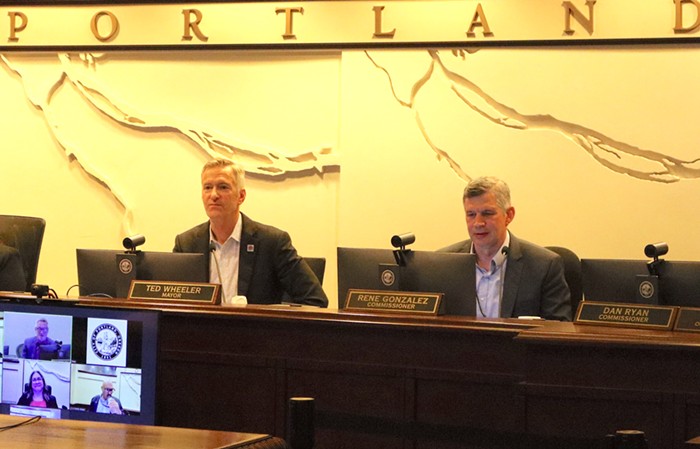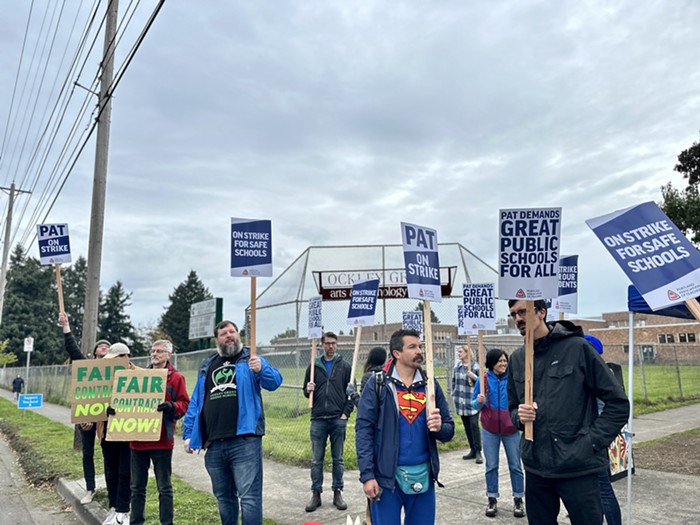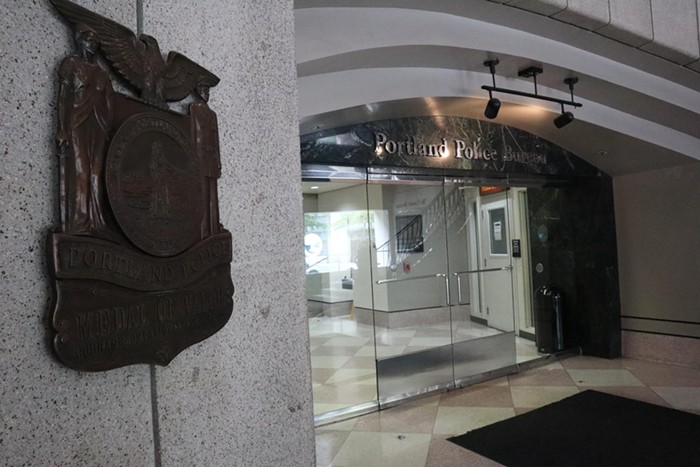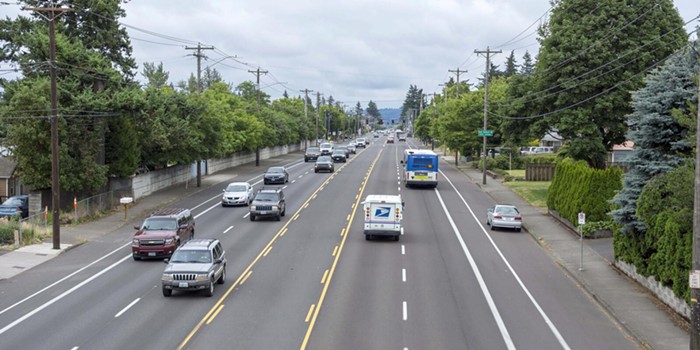ON SOME DAYS, Portland’s stretch of Interstate 5 suffers from what engineers call “hyper-congestion,” a near-complete breakdown of traffic that cuts the freeway’s efficiency roughly in half. The plan to add two auxiliary lanes to smooth the road’s path through the Rose Quarter wouldn’t change that for long.
Farther east, Interstate 205 has some of the same problems during peak travel times, and similar expansion plans for that highway won’t be enough to lastingly stop the daily crawl, either.
In fact, according to a firm hired by the Oregon Department of Transportation (ODOT), none of the dozen highway-widening projects that are currently being planned in and around Portland by state officials would be enough in coming years to stem the increasing congestion choking Portland highways.
“Baseline, significant congestion will exist in 2027 on the I-5 and I-205 study corridors, even with all the improvements” currently envisioned, reads a new analysis from Montreal-based engineering firm WSP. “This congestion impacts not only speed, but also the number of vehicles that the facility can accommodate, with consequential impacts upon quality of life, economic vitality, and vehicle emissions in the region.”
That’s a notable thing to read in a report commissioned by ODOT, which is a relentless champion of highway-widening projects. But it’s not surprising. In the face of vocal opposition to the plan to widen I-5 in the Rose Quarter, the agency has been forced to acknowledge that adding lanes won’t ultimately ease the city’s commuting woes.
Now some local leaders are asking a follow-up question. As officials study the concept of fighting congestion—and potentially curbing auto use—by tolling portions of I-5 and I-205, some want to know if tolls could aid commuters even without the state dropping billions on new highway lanes.
“What would be the impact of tolling all roads everywhere, assuming roads look like what they look like now?” Metro Councilor Craig Dirksen asked at a February 28 meeting of the state’s 25-member Value Pricing Advisory Committee, which is slated to recommend a scheme for tolling by the end of the year. “That’s a scenario that needs to be considered.”
“I think that’s a worthwhile look to have,” said another committee member, Multnomah County Commissioner Jessica Vega Pederson, a short while later.
Gerik Kransky, policy director for the active transportation advocacy group the Street Trust, also pushed the concept.
If ODOT follows their lead, Portland could get a sense of how tolling, by itself, could ease the city’s traffic woes. Anti-highway activists suggest such information would offer valuable context when deciding, say, whether a $450 million widening project makes sense.
The analysts hired by the state seem to bolster that point, saying tolling could have a meaningful impact without widening local highways.
“There’s nothing about the projects not being [built] that would change the fact that pricing would do well,” MSP engineer Chris Swenson told officials at last week’s meeting. “If it’ll do well with those projects in, it will do well with those projects out.”
But as of now, it looks like the calls will go unaddressed. At the meeting, ODOT officials said such an analysis was outside of the committee’s purview, and that the group is forced to proceed under the assumption that all the planned highway projects will be built.
“We don’t have it within the scope of our work to remove projects from the regional plan,” ODOT Project Manager Judith Gray said at the meeting.
Other officials were openly hostile to the idea of instituting tolls without also expanding area highways.
“There’s a growing acceptance that congestion pricing may relieve congestion, but it’s not the ultimate answer,” said Clackamas County Commissioner Paul Savas. “If the public sees a toll, they want to see a benefit.”
The issue is one of many sticking points confronting the value pricing committee, which since November has been toiling in relative obscurity—especially considering the immense impact its work could have in the region.
Depending on the recommendations that come out of that group, the state could toll every lane of both I-5 and I-205 from the Columbia River to where the two highways meet in Tualatin. That’s an option favored by the City of Portland.
Alternately, the state could settle on a far more limited approach—or none at all. Other concepts under consideration include tolling a single bridge (the Abernethy, where I-205 crosses the Willamette River), constructing tolling lanes on a larger stretch of I-205, tolling all existing lanes on a segment of I-5 through downtown, and tolling a lane of I-5 in each direction just south of the Interstate Bridge.
“What we’re really looking at right now is: Is this feasible?” Sean O’Hollaren, the advisory committee’s co-chair and a member of the Oregon Transportation Commission, said at the February 28 meeting. “If so, what does it look like?”
The conversation around tolling is complex, with traffic engineers’ obsession with efficiency butting heads with environmentalists’ concerns about cars’ carbon emissions. Both positions potentially collide with equity advocates’ insistence that economically disadvantaged drivers could be disproportionately affected by any pricing scheme.
The push and pull also ropes in geographic concerns. Vancouver officials look at the issue far differently than their Portland counterparts, who are at odds with those in Clackamas County.
Because of all this, precious little is known about what sort of tolling system—if any—the state might move forward. The value pricing committee has just three meetings left, yet still doesn’t know where or how it will toll, what the cost will be, how carbon emissions would be affected, and what steps the state would take to assist low-income residents.
The sheer magnitude of those unknowns has officials pleading for more time.
“I am writing to respectfully request that the Oregon legislature slow down the process and allow for more public input,” Dirksen, the Metro councilor, wrote on behalf of a committee of regional officials in a February 16 letter to legislators. “This is a new concept and people need time to understand the benefits and potential impacts of congestion pricing.”
State Sen. Lee Beyer, a key lawmaker on transportation issues, has since suggested that such a delay is unlikely. ODOT, it seems, shot down that suggestion, too.
“In consultation with ODOT,” Beyer said, according to the Portland Tribune, “we were told they do not perceive a need for delay on the value pricing study at this time.”


















